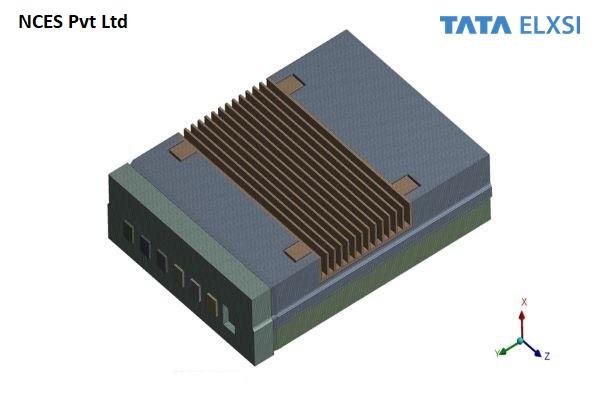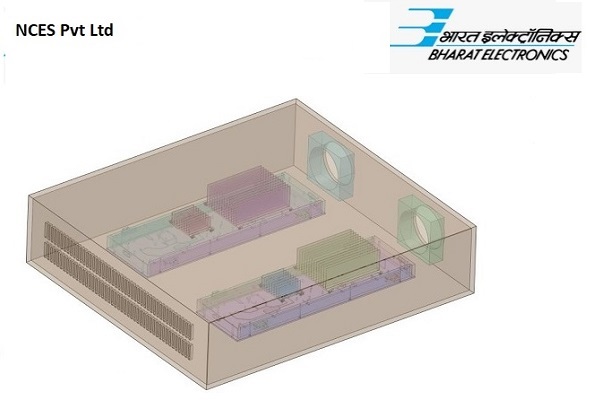INTRODUCTION
The advent of 5G technology has brought about unprecedented advancements in wireless communications, enabling faster speeds, lower latency, and increased capacity. These advancements are associated with higher power consumption and increased heat generation in the 5G Remote Radio units. Increasing data rates and network densification require radio units to process larger volumes of data, leading to higher power consumption and heat generation. Environmental factors such as ambient temperature, humidity, and exposure to direct sunlight also impact the thermal aspects of the radio units. To prevent overheating and ensure optimal performance, efficient thermal cooling solutions are necessary for Remote Radio units. Thermal cooling solutions not only ensure optimal performance but also increase the lifespan of RRUs, reduce maintenance costs, and enhance overall network reliability. Computational Fluid Dynamics (CFD) analysis empowers engineers to replicate the intricate heat transfer occurring in remote radio units and examine their thermal behavior in various scenarios. The accurate results obtained from CFD analysis enable engineers to make informed decisions and devise effective strategies to tackle thermal challenges, ensuring that 5G radio units operate within safe temperature ranges.
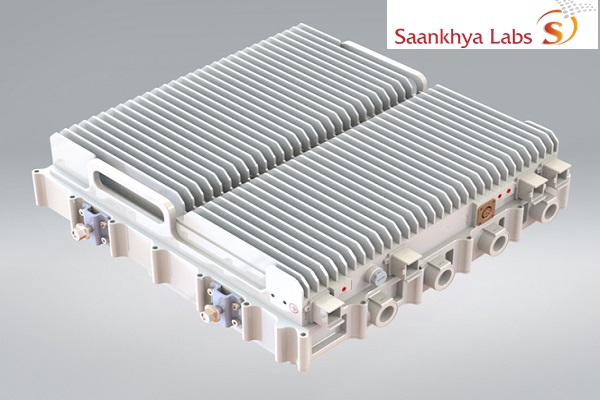
OUR ESTEEMED CLIENT
Our esteemed client is a subsidiary of the renowned Tata Group, which happens to be India's largest conglomerate. They are currently engaged in the development of a cutting-edge 5G Remote Radio Unit (RU) that complies with the ORAN 7.2x standards. Recognizing our expertise in the field, the client has entrusted us with the responsibility of conducting Computational Fluid Dynamics (CFD) analysis for the Remote Radio Unit to assess the thermal performance of the existing design of the Remote Radio Unit and to recommend design changes for enhancing the heat transfer. We are honored to have been chosen for this significant project and are committed to delivering exceptional results.
THERMAL CONFIGURATION
The Remote Radio Unit considered for CFD analysis utilizes a passive cooling technique. The CAD design comprises various components such as the heat sink cover, power amplifier PCB, power amplifier PCB RF shield, power supply plus baseband PCB, power supply plus baseband PCB RF shield, SSG PCB, SSG PCB RF shield, cavity filter, and other mechanical housing.
CFD MESH
Simplified CAD model of the Remote Radio Unit is meshed with Poly-Hex core elements. The mesh size is 24 million. The mesh is refined in the high thermal gradient regions and boundary layer region.
CFD MODELLING
The flow is modeled as 3D, steady state, incompressible, viscous, and turbulent. Turbulence closure is modeled with the K-Omega SST Turbulence model, which accurately captures the boundary layer across the heat sink fins. Radiation inside the Remote Radio unit is modeled with a surface-to-surface (S2S) radiation enclosure model.
BOUNDARY CONDITION
CFD analysis is carried out for wind speeds ranging from 1 to 2.5 m/sec and ambient temperatures ranging from 45 to 55 degrees Celsius.
HEAT DISSIPATION AND JUNCTION RESISTANCE
Total heat dissipation of the Remote Radio unit is about 600 Watts, with heat flux up to 35 W/cm2. All the heat dissipating components are modeled as 3D objects and volumetric heat load (W/m3) is imposed. Contact Resistance at the Junction is modeled as per the manufacturer provided resistance values.
Temperature distribution
CFD analysis results have helped us visualize and analyze the heat transfer mechanisms and identify areas that need attention. During post-processing, our main focus is on the junction temperature of all electronic units, heat flux contour plots, and temperature contour plots. These data have enabled us to identify areas that need attention and come up with strategies to enhance heat transfer and achieve better cooling of the electronics. By simulating different scenarios and analyzing the results, we have fine-tuned the cooling mechanisms to ensure maximum cooling efficiency.
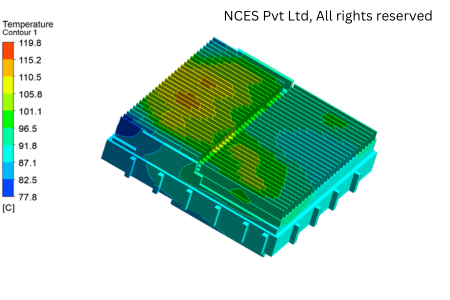
Heat flux
CFD analysis results have helped us visualize and analyze the heat transfer mechanisms and identify areas that need attention. During post-processing, our main focus is on the junction temperature of all electronic units, heat flux contour plots, and temperature contour plots. These data have enabled us to identify areas that need attention and come up with strategies to enhance heat transfer and achieve better cooling of the electronics. By simulating different scenarios and analyzing the results, we have fine-tuned the cooling mechanisms to ensure maximum cooling efficiency.
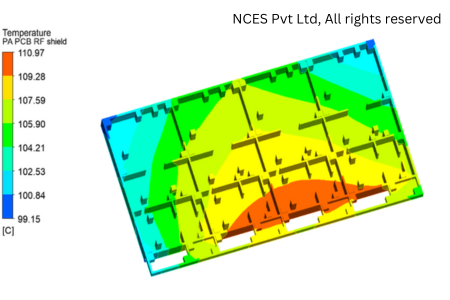
We Got More
Go through All Our Case Studies
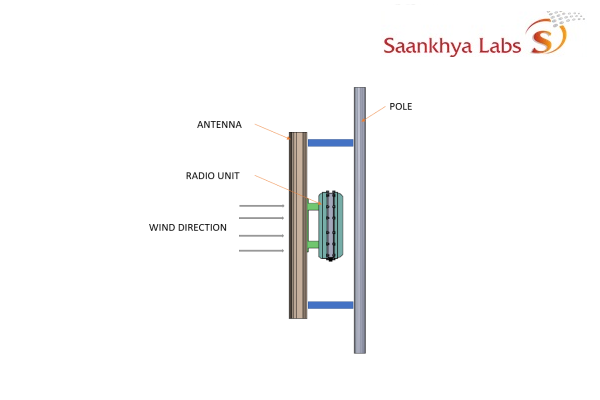
Wind Load analysis for multiband 5G Remote Radio Unit with Antenna using CFD
The seamless operation of base station antennas is of utmost importance for efficient and reliable communication networks. However, these antennas are constantly exposed to various environmental factors that can affect their performance and structural stability. Among these factors, wind load plays a significant role. Read MoreDEVELOPMENT OF COOLING SOLUTION FOR GaN RF POWER AMPLIFIER
The demand for high-power and efficient radio frequency (RF) power amplifiers has been steadily increasing across various industries, including wireless communications, radar systems, and satellite communication. GaN (Gallium Nitride) technology has emerged as a game-changer in RF power amplification due to its exceptional performance characteristics and advantages over traditional technologies. GaN technology offers higher power density, improved efficiency, and wide bandwidth capability, setting it apart from traditional technologies like GaAs (Gallium Arsenide) or SiC (Silicon Carbide). Read More
AERODYNAMICS ANALYSIS OF TELECOM TOWER STRUCTURE
By meticulously considering the principles of aerodynamics in the design of telecom towers, engineers can effectively reduce wind induced vibrations. This not only enhances the overall experience for everyone but also guarantees the towers long term structural integrity and stability. Read More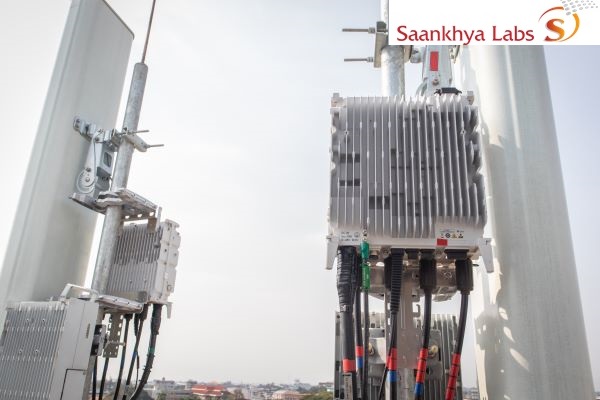
Structural (FEM) analysis for Triband Radio unit with antenna
In this project, we performed FEM analysis to check strength of the triband antenna model for the given load conditions. FE mesh consists of higher-order Tet elements & Hexahedral elements. Mesh size is 2810173 nodes & 1611495 elements. Appropriate contacts are modeled between all the parts in the assembly. FEM analysis is carried out as per the load conditions provided by the customer. We carried out Modal Analysis, Sine sweep Analysis (Harmonic Analysis), Random Vibration Analysis, Shock Analysis, Seismic Analysis, and Wind load Analysis. Read More
Structural analysis for 5G Remote Radio Unit (RRU)
The advent of 5G technology has revolutionized the telecommunications industry, ushering in a new era of ultra-fast data speeds, low latency, and advanced network capabilities. Amidst this transformative landscape, the 5G Remote Radio Unit (RRU) emerges as a critical component, playing an instrumental role in the deployment and optimization of 5G networks. With 5G networks, RRUs have evolved to handle higher data volumes and faster speeds. They are designed to support an increasing number of devices and provide seamless connectivity even in densely populated areas. These modern marvels are a testament to the incredible progress made in wireless technology. Read More